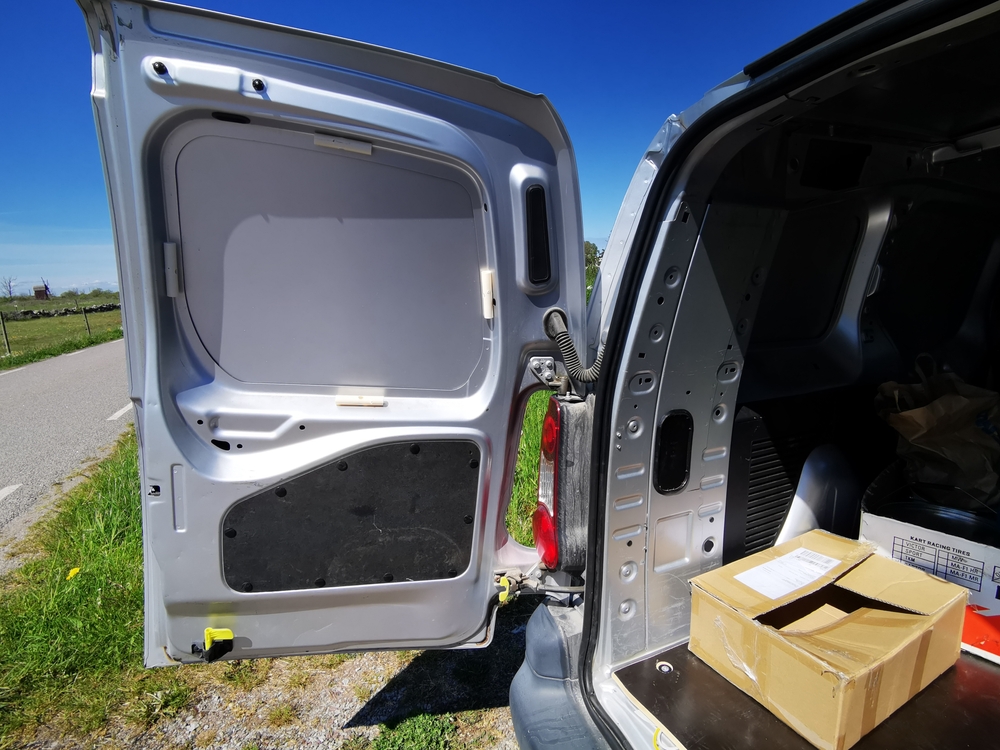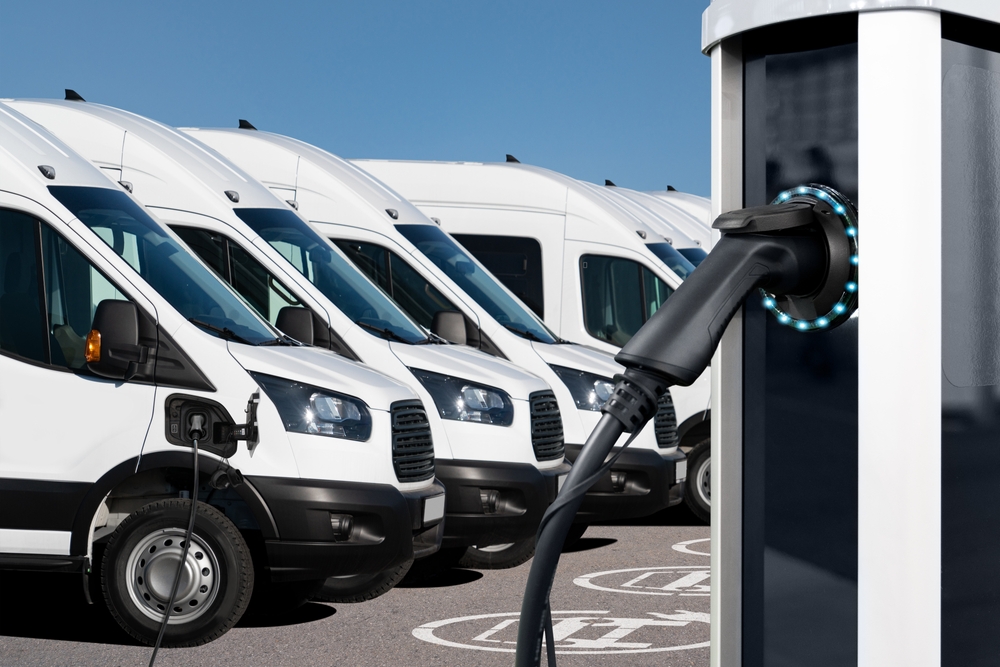It isn’t just electric cars that are breaking the mould – the electric van market is also positively booming!
More and more people are turning to electric vans, whether to transport goods, go on holiday, or use as a daily driver. Not only do they deliver zero exhaust emissions, but they still provide ample payload and carrying capacity.
If you’re ready to go electric, one of the most important factors to consider is electric van range. We’ve done the legwork for you and found the top 9 electric vans, based on battery range.
The Top 9 Vehicles with the Best Electric Van Range
We’ve scoured the UK electric van market and put together a list of the best options based on battery range.
If you’re considering switching to an electric van, here’s what your money can buy, and how far you can expect your vehicle to travel on a charge.
1. Renault Master E-Tech – Range: 285 miles
Topping the list is the new Renault Master E-Tech which can cover up to 285 miles between charges – a massive improvement on the lowly 115 miles of battery range that older versions offered. This large panel van feels more like a regular car inside right down to the openR Link infotainment system found in many Renault vehicles. A digital driver’s display, air conditioning, rear parking sensors, and automatic headlights and wipers all come as standard. The impressive electric van range of the E-Tech goes hand-in-hand with a smooth driving experience, making it a highly desirable choice.
Maximum WLTP combined battery range: 285 miles. Maximum payload: 1,625kg. Maximum load volume: 14.8 cubic metres. Price: from £46,755
2. Volkswagen ID.Buzz Cargo – Range: 276 miles
The Volkswagen ID.Buzz Cargo effortlessly combines cool retro looks with modern design plus a whopping 276 miles of electric van range on the WLTP combined cycle. It shares the same MEB (modular electric drive kit) as other electric Volkswagen models including the ID.5 and ID.4 SUVs plus the ID.3 hatchback. As a result, the ID.Buzz Cargo is incredibly car-like to drive and the suspension can absorb humps and bumps with ease. Despite its comparatively compact size, there’s still plenty of room on board and its good looks are guaranteed to get your business noticed.
Maximum WLTP combined battery range: 276 miles. Maximum payload: 710kg. Maximum load volume: 3.9 cubic metres. Price: from £43,541.
3. Mercedes Benz eSprinter – Range: 272 miles
If you’re looking for a large panel van with a premium badge and sizeable range, the Mercedes eSprinter could be a viable option. However, these features don’t come cheap when compared with other options on this list. For your money, you’ll get a heated driver’s seat, air conditioning, plus the Mercedes MBUX multimedia system as standard. All this goes with a host of hi-tech safety features including active brake assist, intelligent speed assist, hill-start assist, lane assist, and blind spot assist.
Maximum WLTP combined battery range: 272 miles. Maximum payload: 1,273kg. Maximum load volume: 14 cubic metres. Price: from £58,740.
4. Ford E-Transit – Range: 249 miles
A major attraction of the Ford E-Transit is that you get the same amount of space as the traditional diesel option along with a more than decent electric van range of 249 miles. Despite its bulky 15.1 cubic metres maximum load volume, the E-Transit is nippy and nimble, especially the 265bhp version. The cabin is comfortable and there’s ample storage space. You’ll get Ford’s SYNC4 12-inch touchscreen as an option along with cruise control, climate control, various driver safety aids. The E-Transit comes in a variety of sizes with optional extras, so it’s highly likely there’s a version to suit your specific needs.
Maximum WLTP combined battery range: 249 miles. Maximum payload: 1,745kg. Maximum load volume: 15.1 cubic metres. Price: from £57,654.
5. Fiat E-Ducato – Range: 230 miles
Buyers will be spoilt for choice when it comes to finding the right Fiat E-Ducato. There are 28 body styles in all including 3 length and 3 height variants of panel van. You can even select which chassis cab setup you want, or whether to go for the 9-seater passenger version. Cargo volumes and payloads provide bags of space, while the 47kWh models offers up to 146 miles and the 79kWh option 230 miles. Recharging rates have also improved thanks to the E-Ducato’s 150kW peak DC rapid charging.
Maximum WLTP combined battery range: 230 miles. Maximum payload: 1,460kg. Maximum load volume: 17 cubic metres. Price: from £59,382.
6. Citroen e-Dispatch / Fiat e-Scudo / Peugeot e-Expert / Vauxhall Vivaro Electric – Range: 219 miles
Parent company Stellantis cleverly cut costs by sharing the same platform and basic design for the Citroen e-Dispatch, Fiat e-Scudo, Peugeot e-Expert, and Vauxhall Vivaro Electric. Not only that, but the Toyota Proace Electric also belongs in the same category of medium-sized panel vans. Whatever version you go for, you’ll get up to 6.6 cubic meters of load space and around 1,275kg payload which is close to what diesel versions offer. Along with a competitive 219 miles electric van range, models are stacked with safety and communication features, and also come as a double-cab option for those who carry both cargo and passengers.
Maximum WLTP combined battery range: 219 miles. Maximum payload: 1,275kg. Maximum load volume: 6.6 cubic metres. Price: from £46,053.
7. Citroen e-Berlingo / Fiat e-Doblo / Peugeot e-Partner / Toyota Proace City Electric / Vauxhall Combo Electric – Range: 213 miles

Another use of shared battery technology from Stellantis, the Citroen e-Berlingo, Fiat e-Doblo, Peugeot e-Partner, Toyota Proace City Electric, and Vauxhall Combo Electric boast the same e-technology resulting in a maximum 213-mile range. You’ll find a large variety of model sizes and capacities to choose from, while fast charging technology can achieve an 80% charge in around 30 minutes for added convenience. The Toyota Proace City Electric has a key advantage over its small electric van rivals in that maintenance is covered by a 10-year service warranty, which is significantly longer than the Citroen, Fiat, Peugeot, and Vauxhall.
Maximum WLTP combined battery range: 213 miles. Maximum payload: 718kg. Maximum load volume: 4.4 cubic metres. Price: from £26,893.
8. Ford e-Transit Custom: Range 209 miles
The massively popular Transit Custom medium panel van now comes in an electric version with a range of 200+ miles. In fact, you could easily mistake the Ford e-Transit Custom for its diesel and plug-in hybrid siblings because they look so similar. The drive is smooth and pleasing, it comes with bags of kit as standard, and there’s ample room for cargo. While the e-Transit Cargo may not be able to compete with other models in terms of electric van range, its 64kWh battery pack can comfortably handle longer trips.
Maximum WLTP combined battery range: 209 miles. Maximum payload: 1,088kg. Maximum load volume: 6.8 cubic metres. Price: from £53,880.
9. Nissan Townstar / Mercedes eCitan / Renault Kangoo E-Tech: Range 186 miles
As one of the first electric vans to hit the roads, the Kangoo ZE has benefited from a significant upgrade to become the Kangoo E-Tech. It also shares the same genetics as the Nissan Townstar and Mercedes eCitan. The result is a trio of small electric vans with sleek styling, responsive driving, and an electric van range of up to 186 miles. Despite their compact size, all three options still offer plenty of cargo storage along with a smooth ride.
Maximum WLTP combined battery range: 186 miles. Maximum payload: 975kg. Maximum load volume: 4.3 cubic metres. Price: from £39,240.
…not forgetting the plug-in hybrid van nudging 400 miles per gallon
If a battery electric vehicle is not for you, consider the LEVC VN5 – a plug-in hybrid medium-sized van with a vast range nudging 400 miles. The secret is electric motors with a 34.6 kWh battery charged by a combustion engine. The VN5’s all-electric range is only 74 miles. When the battery runs flat, the engine kicks in to produce a total range of 308 miles, making it ideal for both local trips and motorway runs. If the VN5 looks familiar, it’s became it’s made by the same manufacturer as London’s black cabs.
Maximum WLTP combined mpg: 382 miles. Maximum payload: 830kg. Maximum load volume: 5.5 cubic metres. Price: from £64,740.
What are the Benefits of Electric Vans?
Electric vans are shaping the future of commercial and private vehicles. They offer an environmentally friendly and cost-effective alternative to polluting diesel models. With electric van ranges increasing all the time, it could be time for you to switch over too!
The benefits of electric vans include:
Environmentally Friendly
Electric vans are friendlier to the environment than traditional diesel and petrol models. They produce fewer emissions and pollutants both during production and when generating electricity to power them. Not only does this help combat climate change, but it also reduced air pollution in our towns and cities.
Government Incentive Schemes
Some electric vans quality for the OLEV government grant for vans. This can knock up to 35% off the list price of an electric van, significantly closing the price gap between EVs and diesel or petrol vans. Grant funding towards the cost of installing charging points at work and home are also available from the UK government.
Low Running Costs
A major advantage of electric vans is their low daily running costs compared to diesel and petrol alternatives. A traditional van covering 20,000 miles a year is likely to cost around £3,000 in fuel compared to £500 for an electric model. You can also forget about additional charges like London’s Congestion Zone Charge.
Superb Driving Experience
Electric vehicles are much quieter than diesel and petrol vans. The smooth hush that comes with an electric van allows you to cruise along quietly without the distracting noise and rattle of traditional models. Electric van owners will also benefit from the instant torque you get from electric engines which improves acceleration and allows you to nip around town.
Less Maintenance
You won’t have to fork out an arm to keep your electric van on the road. In fact, they are cheaper to maintain than diesel or petrol vans as they have far fewer moving parts than those with combustion engines. Also, the regenerative braking systems on electric vans cause less wear and tear on the brakes, reducing maintenance costs even further.
Need Insurance for Your Electric Van?
At Keith Michaels, we can arrange electric vehicle insurance for a range electric vehicles (EVs) at competitive prices. When it comes to insuring your electric van, you’ll want a robust policy you can afford. For more information, contact us today.


